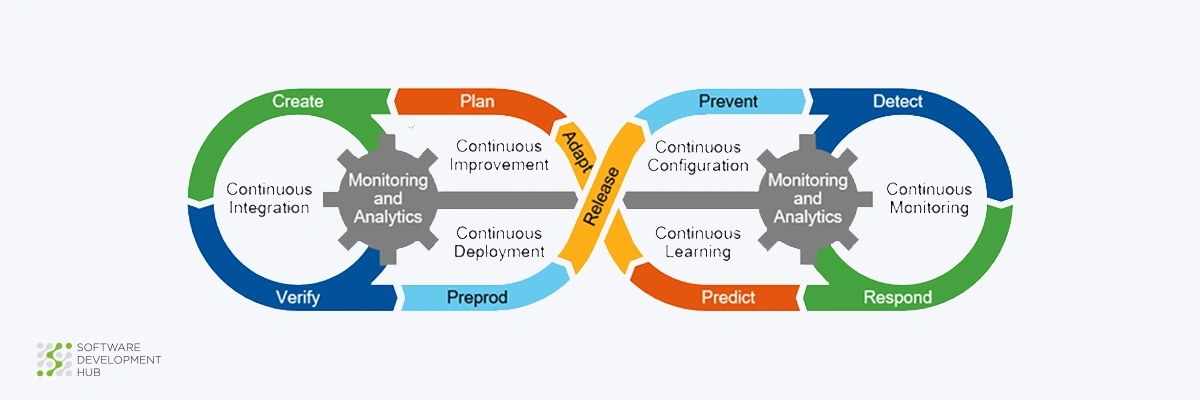DevOps as a service vs Devops managed service
Are you unsure about Managed DevOps or DevOps-as-a-Service for your company's IT plan? Many people struggle with this choice. The tech world changes fast. Finding the right DevOps way can make a big difference for your business.
This guide will show you 12 key differences between Managed DevOps and DevOps-as-a-Service. This will help you choose the option that best fits your needs.
Whether you're a new company wanting to improve or a big company aiming to change your IT, this article will show you how to improve your DevOps plan. Let's look at which approach will best help your company succeed.
Understanding DevOps and Its Core Principles
At its core, DevOps is about removing barriers between development and operations teams. But it's more than just teamwork. DevOps is a set of practices that streamlines the entire software development process.
Let's break down the core principles:
Continuous Integration and Continuous Delivery in Practice: Continuous Integration (CI) and Continuous Delivery (CD) are key parts of DevOps. They act like the heartbeat of the software development cycle. They help keep things running smoothly and consistently.
Continuous Integration in Action: Imagine you're building a complex Lego structure with a team. CI is like everyone constantly adding their pieces to the main structure, ensuring they fit perfectly.
Here's how it works:
- Developers make code changes and push them to a shared repository.
- The CI server automatically detects these changes.
- It builds the application and runs automated tests.
- Developers receive immediate feedback on their changes.
This constant cycle of integration and testing helps catch bugs early, reducing the cost and time of fixing issues later.
Continuous Integration in Action: Imagine you're building a complex Lego structure with a team. CI is like everyone constantly adding their pieces to the main structure, ensuring they fit perfectly.
Here's how it works:
- Developers make code changes and push them to a shared repository.
- The CI server automatically detects these changes.
- It builds the application and runs automated tests.
- Developers receive immediate feedback on their changes.
This constant cycle of integration and testing helps catch bugs early, reducing the cost and time of fixing issues later.
Continuous Delivery: CD takes over from CI. It's about keeping your software ready to deploy anytime. Think of it like having your suitcase packed for a trip. You're ready to go when needed.
The CD process typically involves:
- Automatically deploying to a staging environment after CI passes.
- Running more comprehensive tests.
- Preparing the release for production deployment.
With CD, you can deploy new features or fixes to production with a simple button click or even automatically.
The Power of Automation: Both CI and CD rely heavily on automation. It's like having a tireless robot assistant that handles repetitive tasks, freeing up humans for more creative work. Automated testing is a crucial part of this process. It acts as a safety net, catching potential issues before they reach users. By implementing CI/CD practices, teams can achieve faster release cycles, improved code quality, and more reliable deployments.
Understanding Managed DevOps vs DevOps-as-a-Service
Ever wondered how big tech companies manage their complex software? They use DevOps. But there's a choice - DevOps-as-a-Service or managed DevOps. Companies can pick between two types of DevOps. The first is managing DevOps themselves. The second is having a managed DevOps service handle it for them. Both options allow companies to run their complex software systems efficiently.
DevOps as a Service (DaaS) is changing how we build, use, and maintain software. It's not just a trending term; it's a new way to develop software. DaaS is transforming the software development world. It's a big change in how we create, release, and maintain software products.
Imagine a world where developers and operations teams work together well. DevOps aims to make this happen.
DevOps as a Service is a way of developing and managing software. With DevOps as a Service, a team works together to build, test, and deliver software. This team includes developers, IT operations, and others. They work as one team to quickly make changes and improvements. This helps companies deliver software faster and more reliably.
It's a model that gives the needed tools, steps, and know-how to use DevOps ideas in your company. Think of it as having a team of DevOps experts ready to help make your development process run smoother.
With DaaS, you're not just trying a new way. You're accepting a change in your company culture. This change focuses on working together, automating tasks, and always improving. Faster development means new features arrive sooner. Better code quality means fewer problems. Happier customers means they are more satisfied.
Whether you are a startup wanting to grow fast or a large company trying to stay ahead, DevOps as a Service can help. It blends development and operations in a smooth way. This can push your software projects to new levels of success.
On the other hand, Managed DevOps is like ordering food from a special service. You get tasty results without the work of cooking. In this case, companies give their DevOps needs to specialized service providers.
Managed DevOps is an outsourced approach. It brings expertise and efficiency. It's like having a top chef cook your meals. These services often use advanced managed DevOps platforms. This helps streamline operations.
DevOps isn't only about tools. It's a culture where development and operations teams work together. The goal is to create a smooth, efficient software development process. Managed DevOps is like having a personal chef for your IT work. A provider handles your entire DevOps process. They do everything from writing the code to deploying the final product. They bring their own strategies and tools, customizing them for your needs.
And DevOps-as-a-Service is more like a meal kit service. You get all the tools and infrastructure delivered, but you still do the work. It's a cloud-based, subscription plan that gives you on-demand access to DevOps tools. Choosing between these options depends on your organization's needs, resources, and goals. Both can help you reach your fitness goals, but the path will be different.
Key differences between DaaS and Managed DevOps
Many organisations now adopt a DaaS platform for speed and standardisation, while engaging a managed service provider for architecture, security and governance. The decision matrix in 2025 includes factors such as tool-sprawl risk, in-house maturity of platform engineering, multi-cloud/edge readiness, cognitive load, and developer experience (DX).
Benefits of each model
Additional benefits in the 2025 driven landscape:
-
AI-powered automation simplifies pipeline tasks, reduces manual effort and cognitive load for developers.
-
Platform engineering-led DaaS models can reduce time-to-value by up to 30% (industry benchmark).
-
Managed service partners offering governance-ready frameworks help regulated enterprises with audit-readiness, compliance automation and integrated FinOps control.
Key Factors to Consider When Choosing Your DevOps Strategy
Choosing the right DevOps strategy is like picking the perfect outfit for an important event. You need to consider various factors to make the best choice. Here are some key considerations:
- Company size and resources
- Budget constraints
- Existing IT infrastructure
- Team's technical expertise
- Project complexity
- Security requirements
- Scalability needs
These things act like a compass. They show you the best DevOps approach for your needs. For example, if you're a small startup with few resources, managed DevOps might work best.
Remember, this is an important choice. It can greatly affect your business. It's like choosing between buying a car or using a ride-sharing service. Both get you where you need to go, but the experience and long-term effects are different.
Key Features of Managed DevOps
Managed DevOps is like having an experienced captain steer your DevOps ship. A third-party provider leads your organization's DevOps process. This outside team of experts brings a lot of knowledge and experience.
Imagine you're running a factory. Instead of hiring a whole team, you hire experts who know the production process well. That's what Managed DevOps does for your IT work. This method is great for managing processes. It's not just about using tools. It's about improving your entire DevOps workflow. Your managed DevOps provider carefully coordinates every step. This includes from code commits to deployment.
One of the biggest advantages is that you can focus on your main business. Experts manage the details of DevOps. It's like having an IT team, but without the cost of hiring and training people.
Key Features of DevOps-as-a-Service (DaaS)
DevOps-as-a-Service (DaaS) is like having a complete gym right at your fingertips. It's a cloud-based part of your IT plan. DaaS gives you a variety of DevOps tools and services on a subscription basis.
Imagine a room with all the DevOps tools you need ready to use. That's DaaS. It gives you access to DevOps tools like version control and continuous integration. You can use these tools whenever you need them. DaaS makes it easy to get the tools you need for your DevOps work.
This subscription model means you don't own the equipment. You rent it when needed. It's like a gym membership. You can use any machine or take any class. But you don't have to worry about maintenance or upgrades.
DaaS lets organizations try DevOps without a big upfront cost. It allows you to test different tools and processes. This helps find what works best for your team. You don't have to commit to an expensive long-term solution.
Moreover, DaaS platforms are made to change with the fast-changing DevOps field. New tools and features are added often. This means you always have the latest and best DevOps technology.
Key Benefits of DevOps as a Service
DevOps as a Service isn't just a fancy term - it's a powerhouse of benefits that can transform your software development process. Let's dive into the key advantages:
Supercharged Developer Productivity: Imagine your developers like race car drivers. DevOps as a Service gives them a pit crew that does everything except driving. With automated processes and smooth workflows, developers can focus on writing great code. They won't get stuck in operational work or deployment problems.
Faster Time to Market: In the digital world, speed is very important. DevOps as a Service gives you a fast way to the market. You can automate manual tasks and have continuous updates. This lets you add new features quickly. It's like having a high-speed train for your software releases.
Enhanced Customer Satisfaction: Happy customers are the lifeblood of any business. DevOps as a Service helps you keep them smiling. With faster releases and improved quality, you can respond to customer needs more quickly. It's like having a direct line to your users' wishes.
Competitive Edge: INowadays, staying ahead is key. DevOps as a Service gives you the boost you need. It lets you innovate faster and have more reliable releases. This helps you stay ahead of competitors. It's like having a secret weapon for software development.
Improved Collaboration: DevOps as a Service breaks down the walls between teams. It's like turning your organization into one big, happy family.
Control and Customization Differences
With Managed DevOps and DaaS, the control and customization are different. Each option has its own advantages and disadvantages.
Managed DevOps is like having someone else drive your DevOps journey for you. You're in the car, but not driving it. This approach means you have less direct control over the everyday work of DevOps. But it lets you customize the services to fit your needs, like a tailored suit.
On the other hand, DaaS works like a self-driving car. You're still in charge, but you use advanced technology to reach your goals. With DaaS, you have more direct control over your DevOps processes. You choose the tools to use and how to use them, like picking features in your self-driving car.
In a managed DevOps setup, you can customize deeply. But it may be slower. This is like renovating your house. You get exactly what you want, but it takes time. DaaS lets you customize quickly. But it might not be as comprehensive. This is more like rearranging furniture. It's fast and flexible, but within certain limits.
Cost Considerations
When it comes to DevOps, cost is a crucial factor that can make or break your decision. It's like choosing between buying a car and using ride-sharing services - both have different cost structures that might suit different needs.
DevOps-as-a-Service Costs:
- Hiring and training specialized staff
- Investing in infrastructure and tools
- Ongoing maintenance and upgrades
Managed DevOps Costs:
- Service provider fees
- Potential customization costs
- Contract management expenses
When it comes to money, deciding between Managed DevOps and DaaS is like choosing between buying a car or using a ride-share service. Both have their own costs and benefits. Managed DevOps means you own and manage the technology. This has upfront costs but you control it. DaaS is a service you pay for. There are no upfront costs, but you don't control the technology. The right choice depends on your needs and budget. Managed DevOps gives you more control but costs more upfront. DaaS has lower upfront costs but you have less control. Think about what's important to your situation when making this decision.
Managed DevOps often costs more upfront. You're hiring a full-time DevOps team with their skills and tools. It's like buying a car - a big initial cost, but you have it whenever you need it.
The service provider in a Managed DevOps setup charges a fixed monthly or yearly fee. This fee covers things like tool licenses and expert advice. The fee is predictable, but it can be quite high.
On the other hand, DaaS uses a subscription plan. It's more like ride-sharing. You pay for what you use, when you use it. This can be cheaper for smaller companies or those with changing DevOps needs.
With DaaS, you can pick different service levels. You pay more for extra features or support. It's flexible, so your costs can change with your needs.
However, you should also think about hidden costs. With Managed DevOps, you might save money on training and hiring new people. But with DaaS, you might need to train your team to use the tools properly.
Implementation Speed and Complexity
When starting a DevOps program, Managed DevOps and DaaS are like two different options. Managed DevOps is like a custom-built vehicle. DaaS is like a rental car that's ready to drive.
Managed DevOps takes longer to develop. It's like building a car from the beginning. This takes time, but you get what you want. The provider needs to understand your needs. They customize their approach and integrate with your systems. This process can take weeks or months. But it results in a solution that fits your needs.
And DaaS is made for fast set-up. It's like renting a car - you can be driving quickly. Most DaaS platforms are built to be easy to set up and connect. You can often start using basic features in just days or even hours.
Complexity isn't just about speed. Managed DevOps takes longer to set up, but it can make your long-term work easier. It replaces manual tasks with automated, optimized processes. DaaS is faster to start, but your team may need to manage it more.
Scalability and Flexibility Considerations
In the DevOps world, scalability and flexibility are like superpowers. They let your systems grow with your business. They also let your systems change as your needs change.
Managed DevOps services are flexible. They can grow or shrink based on what you need. For example, if you have a sudden increase in website traffic, a managed service can quickly add more resources to handle it.
Consider a seasonal business, like an online gift shop. During holidays, they might need to quickly scale up. A managed DevOps service could easily handle this.
Security and Compliance Concerns
When it comes to DevOps, security and compliance are like the locks and alarms on your house. They're not just add-ons; they're essential for protecting your valuable assets.
A small fintech startup may gain from a managed DevOps service. These providers often have strong security and compliance certifications. This can be costly for a small company to do on their own.
Remember, security in DevOps isn't just about stopping problems. It's about making security a part of every step in the development process. This combined approach ensures that security is not an extra thing but a key part of your work.
Risks and considerations
Modern risk vectors to address:
-
Vendor lock-in with deep platform or service-provider dependencies; ensure open standards and hybrid interoperability.
-
Tool-sprawl and increased cognitive load: ironically, using many fragmented services may worsen developer productivity and operational overhead.
-
AI-driven automation without human oversight can lead to "shadow-automation" or uncontrolled drift in pipelines.
-
Compliance and policy-as-code gaps: if the service partner does not integrate governance (DevSecOps/FinOps), regulatory or audit exposure increases.
How to choose the right model
Use this 2025-ready selection checklist:
-
Does your organisation already have a platform engineering team or mature DevOps capability?
-
Is developer experience (DX) a defined metric (e.g., deployment lead time, cycle time, cognitive load)?
-
Are governance/compliance/finops key constraints for your business (regulated industry, multi-cloud, security baseline)?
-
Is tool-sprawl or cognitive load hurting your teams?
-
Do you plan to integrate ML/AI workloads (MLOps) or need a unified software supply chain?
If the answers to most questions are “yes”, then a Managed DevOps service may be most appropriate. If the priority is agility, speed and utilising a self-service platform, then DevOps as a Service (DaaS) may deliver more value.
Conclusion
As we've looked at the key differences between Managed DevOps and DevOps-as-a-Service. They both have unique benefits. They can change your IT strategy. Which model you choose depends on your organization's needs, resources, and goals. You can pick the customized Managed DevOps or the flexible DevOps-as-a-Service. Whichever you choose, using DevOps practices can really improve your software development.
Remember, becoming great at DevOps is an ongoing process. No matter which path you take, keep improving. Also, focus on getting feedback and changing with the fast-moving tech world. When you follow DevOps principles, your organization will work better. You'll also get products to market faster. Plus, your dev and ops teams will work together better.
Thank you for joining us. This explores Managed DevOps and DevOps-as-a-Service. The information can help you make a good decision. It will match your IT strategy and help your organization succeed in the digital age.
Categories
About the authors
Share
Need a project estimate?
Drop us a line, and we provide you with a qualified consultation.








